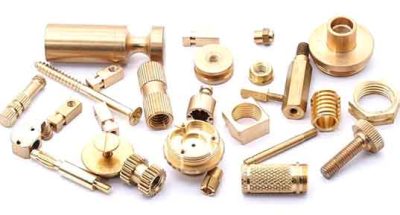銅合金加工 (旋回, フライス加工) 優れた性能と低い抵抗率を備えています. 良好な延性, 高い熱伝導性と電気伝導性, したがって、ケーブルで最も一般的に使用される素材です, コネクタ, および電気・電子部品. 建築材料としても使用でき、さまざまな種類の合金で構成できます。. これらの中で最も重要なものは次のとおりです: ベリリウム銅, リン青銅, 青銅と真鍮. 加えて, 銅は耐久性のある金属でもあり、機械的な旋削やフライス加工の性能を損なうことなく何度でもリサイクルできます。.
CNC回転銅部品の削減量はです 3-4 んん, フィードはです 0.25, 速度は直径に応じて決定されます.
1. CNC旋盤のスピンドル速度は、ワークピースの素材とツールの材料に従って決定されます. 一般的に, 速度が高いほど, フィニッシュが良くなります; フィード速度が速くなります, 処理速度が速くなります; 回転深度が大きくなります, 処理速度が高くなります.
2. 一般的に, 高い旋回速度は、大きな回転の厚さには適していません, より大きなフィードを選択できます. 中程度と低速により、工作機械はトルクが大きくなります, これは、大きい回転の厚さに適しています, そして、フィードが速すぎてはいけません. フィードが大きい場合, 回転の厚さは小さくなければなりません. これらはすべて工作機械の剛性に関連しています, 切削工具, 銅金材料の特性.
3. 銅の大まかな処理は一般に生産性の向上に焦点を当てています, ただし、経済と処理コストも考慮する必要があります; 半仕上げと仕上げのとき, 回転効率, 経済と処理コストは、処理品質を確保するという前提で考慮する必要があります.
4. 供給量はです: ワークピースまたはツールが1つの円または往復を1回回転させるか、ツールが1つの歯を回転させるとき、ワークとフィードの動きの方向にあるツールの相対的な変位.
 銅回転部 |
銅インサート, 六角形の銅インサート. 六角形のバーで直接回転することによって作られています, プロセスは簡単です, それはしっかりしており、挿入物としてプラスチックに注入された後に回転するのは簡単ではありません, そして、エンジニアリングのパフォーマンスが優れています. 左側の写真です: M6銅H10インサートの反対側, M5銅H8インサートの反対側, 銅C3604で作られています. 着床用の六角形のプラスチック銅インサート, インサートとしてプラスチックに注入されます 利用可能な仕様: M2-12. |
 電子銅部品 |
最も使用される六角形の銅インサートナット 左側の画像は、シンプルで実用的な構造を備えた最も一般的に使用される六角形の銅挿入の1つです。. 中溝は六角形のバーで製造されており、内側のスレッドはねじれてbevelです. 生産効率は高く、コストは比較的低いです. 応用: 銅挿入ナットは、カビ噴射によってプラスチック片に注入されます, 信頼性の高いアンチフロジャミエントパフォーマンスを備えています. 左側の画像にある六角形の銅インサートの仕様: M5 * H8 * 10, 仕様を作成できます: M2〜M12, 反対側の長さは制限されていません 左側の画像の銅挿入材料: C3604真鍮, 利用可能な材料: 銅, ステンレススチールとフリーカッティングスチール 左側の画像をクリックして、最大の画像の六角形の銅インサートを表示します |
 機械加工銅ナッツ |
銅の挿入部品よりも六角形側H4の主な使用は、プラスチックメンバーの射出成形生成物です. インストール後, プラスチック部品に効果的な内部スレッドを形成できます. 動作方法は、カビ噴射を直接使用することです, 真鍮には優れた熱伝導率があるためです, そして、成形されたプラスチック部品と銅埋め込み部品は良い組み合わせを持っています. 左側の写真は、仕様の銅に象眼された部分を示していますM4およびM6. |
 English
English العربية
العربية 中文(漢字)
中文(漢字) Čeština
Čeština Dansk
Dansk Nederlands
Nederlands Suomi
Suomi Français
Français Deutsch
Deutsch Italiano
Italiano 日本語
日本語 ಕನ್ನಡ
ಕನ್ನಡ 한국어
한국어 Português
Português Русский
Русский Slovenčina
Slovenčina Español
Español Svenska
Svenska Türkçe
Türkçe

